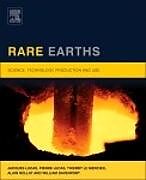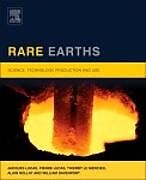Rare Earths
Format:
E-Book (EPUB)
EAN:
9780444627445
Untertitel:
Science, Technology, Production and Use
Genre:
Technik
Autor:
Jacques Lucas, Pierre Lucas, Thierry Le Mercier, Alain Rollat, William G. Davenport
Herausgeber:
Elsevier Reference Monographs
Anzahl Seiten:
407
Erscheinungsdatum:
09.09.2014
High-technology and environmental applications of the rare-earth elements (REE) have grown dramatically in diversity and importance over the past four decades. This book provides a scientific understanding of rare earth properties and uses, present and future. It also points the way to efficient recycle of the rare earths in end-of-use products and efficient use of rare earths in new products. Scientists and students will appreciate the book's approach to the availability, structure and properties of rare earths and how they have led to myriad critical uses, present and future. Experts should buy this book to get an integrated picture of production and use (present and future) of rare earths and the science behind this picture. This book will prove valuable to.non-scientists as well in order to get an integrated picture of production and use of rare earths in the 21st Century, and the science behind this picture.
Defines the chemical, physical and structural properties of rare earths.Gives the reader a basic understanding of what rare earths can do for us.Describes uses of each rare earth with chemical, physics, and structural explanations for the properties that underlie those uses.Allows the reader to understand how rare earths behave and why they are used in present applications and will be used in future applications.Explains to the reader where and how rare earths are found and produced and how they are best recycled to minimize environmental impact and energy and water consumption.
Professor Jacques Lucas is a Ph.D. (University of Rennes, France) in solid state chemistry. He is a member of the French Academy of Sciences and Emeritus professor at the University of Rennes. He has co-authored several books on glasses, ceramics and optics. He has been involved in rare earths research (photonics) as well as teaching for more than 40 years .He published more than 450 articles and co-chaired several international conferences devoted to rare earths doped optical materials. He founded and headed the CNRS Glass and Ceramic laboratory at University of Rennes for 30 years. Three start-up companies were founded based on the laboratory discoveries. He has been associate professor at University of Arizona and invited professor at Kyoto University (Japan) as well as at Shanghai University (China). He is in close contact with Solvay, the world leading company in rare earth separation, as well as with the Chinese and Japanese rare earth scientific community.
Autorentext
Professor Jacques Lucas is a Ph.D. (University of Rennes, France) in solid state chemistry. He is a member of the French Academy of Sciences and Emeritus professor at the University of Rennes. He has co-authored several books on glasses, ceramics and optics. He has been involved in rare earths research (photonics) as well as teaching for more than 40 years .He published more than 450 articles and co-chaired several international conferences devoted to rare earths doped optical materials. He founded and headed the CNRS Glass and Ceramic laboratory at University of Rennes for 30 years. Three start-up companies were founded based on the laboratory discoveries. He has been associate professor at University of Arizona and invited professor at Kyoto University (Japan) as well as at Shanghai University (China). He is in close contact with Solvay, the world leading company in rare earth separation, as well as with the Chinese and Japanese rare earth scientific community.
Leseprobe
Chapter 1 Overview
Abstract
In 2014, ~ 90% of rare earth production originates in the mines of Inner Mongolia, China. High-purity (99.9 mass%) rare earth compounds (e.g., oxides) are produced from these ores by physical concentration, leaching, solution purification, solvent extraction separation, and individual rare earth compound precipitation. About 40% of all rare earth production is used in metallic form for making magnets, battery electrodes, and alloys. Metals are made from the above compounds by high-temperature fused salt electrowinning and/or high-temperature reduction with metallic reductants. Production/consumption of rare earths is ~ 100 kilotonnes of contained rare earth elements per year. The rare earths are mainly consumed in permanent magnets, catalysts, glass polishing powders, rechargeable batteries, and photonics (luminescence, fluorescence, and light amplification devices). Magnets and photonics are expected to grow significantly over the next few years. Keywords Overview Rare earth definition Occurrence Mining Extraction Uses Recycle This book defines rare earths as those elements that are between lanthanum and lutetium on the atomic chart, that is, lanthanum, La cerium, Ce praseodymium, Pr neodymium, Nd promethium, Pm samarium, Sm europium, Eu gadolinium, Gd terbium, Tb dysprosium, Dy holmium, Ho erbium, Er thulium, Tm ytterbium, Yb lutetium, Lu. They are also called lanthanides. In nature, they occur with yttrium (Y) and scandium (Sc), which some authors refer to as rare earths. We discuss these elements, but do not refer to them as rare earths. Lanthanum through samarium account for ~ 98% of rare earths-in-ore, Fig. 1.1. Europium through lutetium account for the remainder (Dent, 2012). Fig. 1.1 Rare earth oxides. Left to right are gadolinium oxide, samarium oxide, neodymium oxide, praseodymium oxide, lanthanum oxide, and cerium oxide. Photo by Peggy Greb, US Department of Agriculture (public domain). The isotopes of promethium are all radioactive with short half-lives. Promethium is never found in nature. The objective of this chapter is to summarize these rare earths in terms of their properties, uses, occurrence, and extraction in preparation for our book's detailed chapters. 1.1 Exploited Properties
Rare earth elements are always used in combination with other elements. Examples are as follows: (a) as oxides in automobile exhaust pollution abatement catalysts (b) alloyed with transition metals (Ni, Co, Mn) and hydrogen in rechargeable battery electrodes (c) alloyed with magnesium to increase its high temperature strength and decrease its flammability (d) alloyed with transition metals (Fe, Co) to make the world's strongest permanent magnets (e) doped into glass to give specific, reproducible wavelength laser output light and (f) doped into compounds, glasses, and polymers for use in luminescent products, for example, lights and screens. The uniqueness of rare earth properties for many of these uses is a consequence of their blocked 4f electron orbitals. 1.2 Uses
Table 1.1 shows world rare earth consumption in 2012. Cerium, lanthanum, and neodymium were by far the most consum
Inhalt
1. Overview 2. Rare Earth Production, Uses and Prices 3. Rare Earths Mining and Concentrate Production 4. Rare Earth Elements Extraction from Concentrates 5. Rare Earths Purification, Separation and Precipitation and Calcination 6. Production of Rare Earth Metals and Alloys - Electrowinning 7. Metallothermic Rare Earth Metal Reduction 8. Rare earths electronic structures and trends in properties 9. Rare Earths based Catalysts 10. Rare Earths in Rechargeable Batteries 11. Rare Earths in Alloys and Metals 12. Polishing with Rare Earth Oxides mainly cerium oxide CeO2 13. Permanent magnets based on Rare Earths: Fundamentals 14. Rare Earths based Magnets: Fundamentals 15. Rare Earths based Magnets: Preparation and Uses 16. Rare Earths Luminescent Materials: Introduction 17. Rare Earths Luminescent Materials: Applications 18. Rare Earth doped Lasers and Optical Am…

Leider konnten wir für diesen Artikel keine Preise ermitteln ...
billigbuch.ch sucht jetzt für Sie die besten Angebote ...
Die aktuellen Verkaufspreise von 3 Onlineshops werden in Realtime abgefragt.
Sie können das gewünschte Produkt anschliessend direkt beim Anbieter Ihrer Wahl bestellen.
Loading...
Die aktuellen Verkaufspreise von 3 Onlineshops werden in Realtime abgefragt.
Sie können das gewünschte Produkt anschliessend direkt beim Anbieter Ihrer Wahl bestellen.
| # | Onlineshop | Preis CHF | Versand CHF | Total CHF | ||
|---|---|---|---|---|---|---|
| 1 | Seller | 0.00 | 0.00 | 0.00 |
